Written by Matthew Cook
In the mid 1920s, John I. Haas began growing hops on his Evans Road farm. By the mid 1950s his company had acquired all of the hop lands in Chilliwack. The hops fields were an important source of seasonal employment for the denizens of Chilliwack, allowing people of many backgrounds to come together and work for a common cause. the company operated for many decades, but due to diminishing sales, it would eventually see closure in mid-October 1997. With this closure, a Canadian industry with more than 100 years of social, cultural and economic history for the people of Chilliwack came to an end.
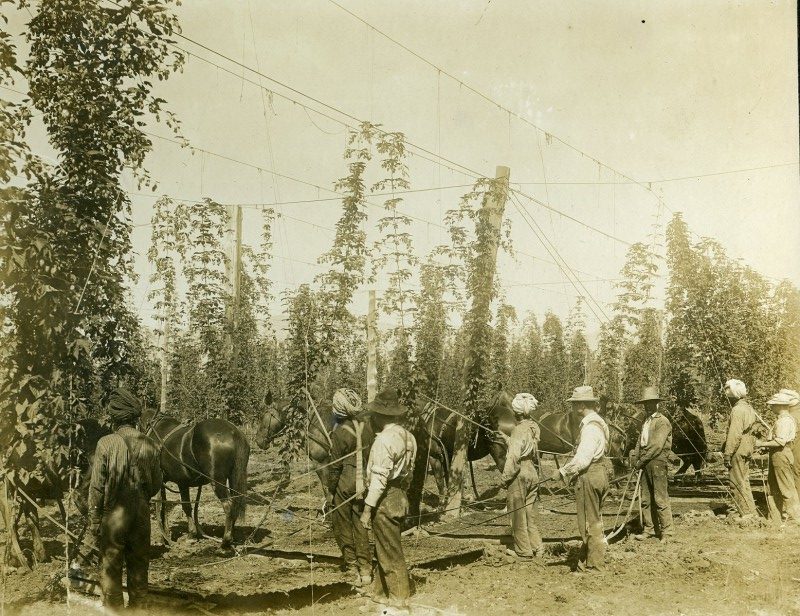
John I Haas fonds, 1999.031.116
Because the John I Haas Company existed for so long in Chilliwack, it witnessed and was subjected to many of the historical events that shaped the community. These events were documented by the company, and compiled into a collection that was donated in 1999 to the Chilliwack archives. The collection sat largely untouched for over twenties years, but was finally fully processed in mid-2022. It was then that many of these documents were unearthed, providing valuable and unique insights involving certain events such as the air raids on Britain and the Japanese Internment during the Second World War, along with the Flood of 1948. This blogpost will explore some of these findings in greater detail, so that they may be of use not just for future researchers, but everyone who calls Chilliwack home.
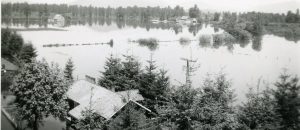
Image of 1948 flood, 1999.031.042 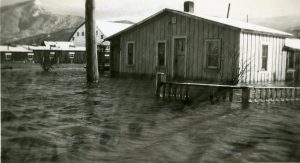
Image of 1948 flood, 1999.031.045
A good portion of the correspondence written during the time of the Second World War make very little mention of the battles taking place, the exception to this, however is File 365. In this bundle of letters from 1941, there is mention of the daily air raids on Britain and how the British people are dealing with it. One letter in specific written by a manager at the John I Haas to a professor E.S. Salmon in England documents the manager’s amazement after reading in the newspaper that an aunt in England age 84 was quoted saying: ‘There have been no air-raids today but I think I hear aeroplanes in the sky. There goes the alert. I am sorry I must stop now as I must go upstairs and change as I have to go out to tea.” Such stoicism represents a fine example of the ‘Keep Calm and Carry On’ mentality the British people adopted during the war, which many Canadians, including Mr. Hinds in Chilliwack, admired and were heavily inspired by.
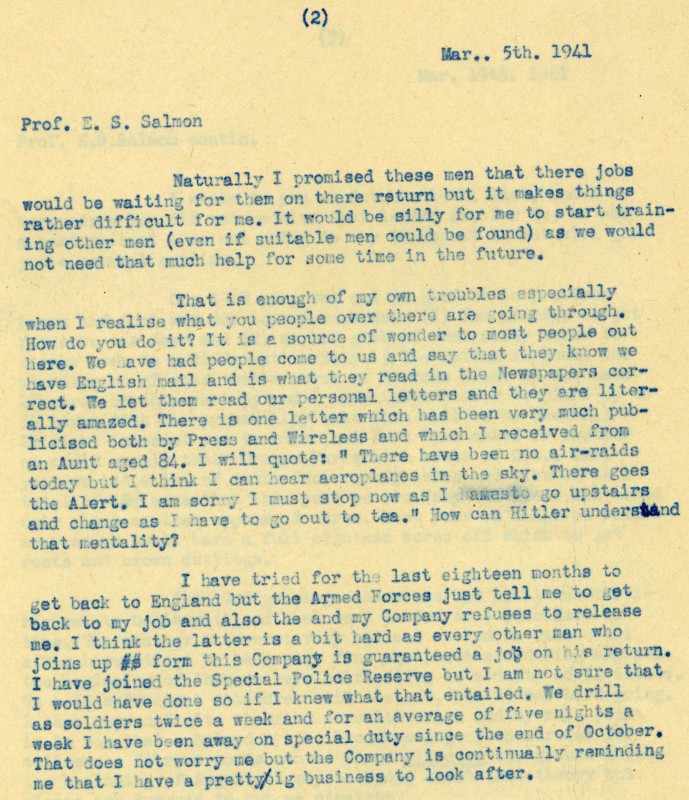
The correspondence series also elaborates on another aspect of the Second World War: The unjust internment of Japanese Canadians. Prior to the 1940s, the John I Haas Company had many people of Japanese descent working on the hops farms. This meant that when Canada and Japan went to war in December 1941, these Japanese-Canadian workers were subjected to the government’s War Measures Act, which forcibly evacuated and detained them to the country’s interior. While processing the John I Haas collection, a series of documents were uncovered that shed more details on the situation at the John I Haas Company at this time. For example, from the letters in File 369, we were able to determine the names of some of the workers who went through this terrible ordeal because in order to comply with the Department of the Secretary of the State, the company was forced to make a list of all their hired Japanese workers.
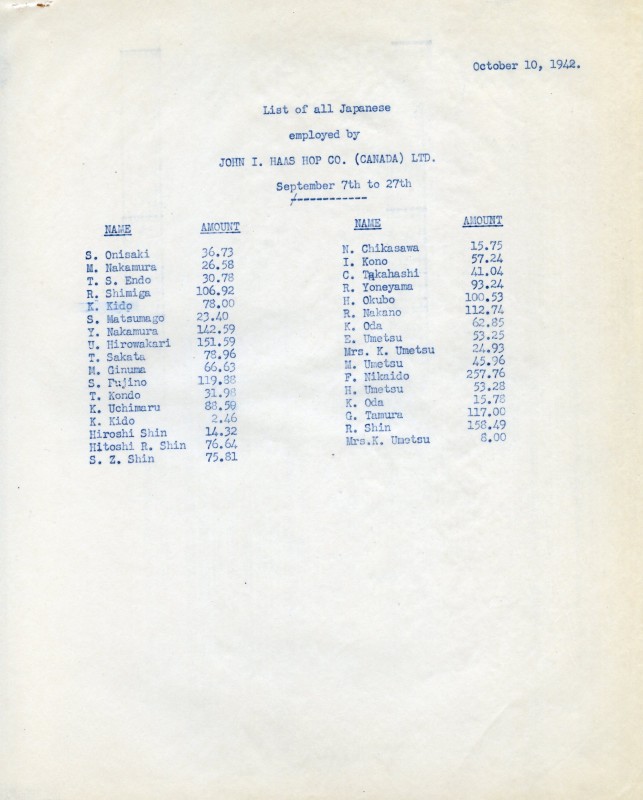
Additionally, several letters indicate that the abrupt evacuation of Japanese workers must have caused a great deal of confusion, as many of their belongings left back at the farms became mixed up with the property of other evacuees.
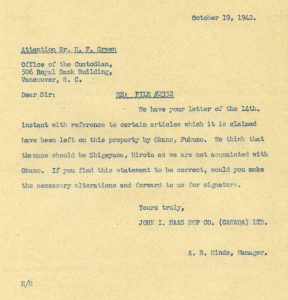
John I Haas fonds, 1999.031, file 369 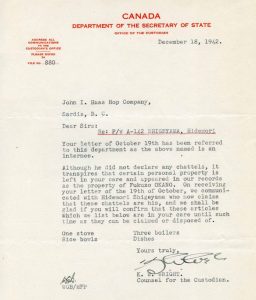
John I Haas fonds, 1999.031, file 369
Furthermore, letters written by the detained Japanese individuals including Iwase and Furukawa to the farm managers reveal that they had not been paid for their work in the hops fields and when requesting the money that was due to them, A.B. Hinds, the manager, wrote back curtly to Mr. Iwase that all the money they made were to go to the Office of the Custodian. These documents, some of which are handwritten, offer a window to the more personal stories during this period of hardship and injustice that occurred right here in Chilliwack.
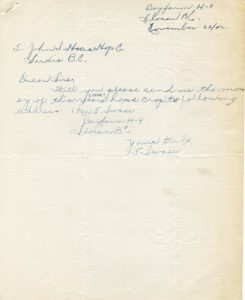
John I Haas fonds, 1999.031, file 369 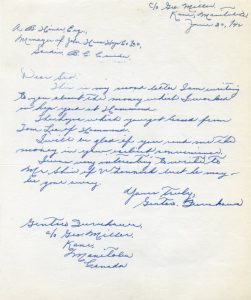
John I Haas fonds, 1999.031, file 369 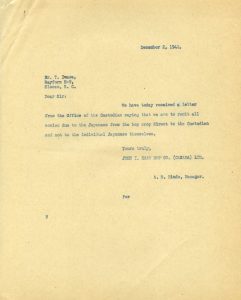
John I Haas fonds, 1999.031, file 369
In 1948, the majority of the Chilliwack region was subjected to a massive flood, one of the worst of its kind in recorded history for the region. Naturally, this flood affected the John I Haas Company as well, but it was only until 2022 that certain documents relating to this event were properly processed. These documents include typed correspondences and telegrams. The first document featured is a formal report on the nature of the flood, giving an excellent breakdown on the causes of the flood, the ensuing damage it was causing to the farms. The second document featured, however, is a telegram that alerts the Washington head office about the dire situation the Fraser Valley farms were currently experiencing, and the fear of further crop destruction. The fact that the message was written as a telegram and not as a typical typed letter to be mailed indicates the anxiety, urgency, and helplessness the workers must have felt as the flood waters continued to rise, risking their livelihoods.
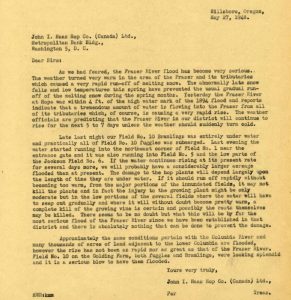
John I Haas fonds, 1999.031, file 379 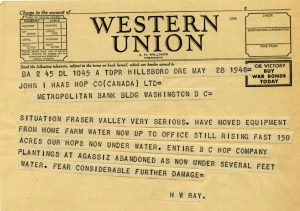
John I Haas fonds, 1999.031, file 379
These are just several examples of the many fascinating documents found during the processing of the John I. Haas Collection. From maps, financial documents, correspondence, to photographs, the collection offers a plethora of information for researchers of Chilliwack’s history to discover.
Enjoyed this blog post?
Be sure to visit the Chilliwack Museum and Archives from February 9, 2023 – June 3, 2023 to see the travelling exhibition, The Suitcase Project, from Nikkei National Museum & Cultural Centre.
The Suitcase Project asks yonsei and gosei (fourth and fifth generation) Japanese Canadians and Americans what they would pack if uprooted from their homes in a moment’s notice.
While these descendants of the internment and incarceration may never have to endure the same forced uprooting as their ancestors, Kayla Isomura’s work examines how they, and those descended from families who experienced other forms of discrimination, remain affected by this history today through a series of photographs, short films and interviews.
Over the course of nearly three months, more than 80 subjects ranging in age and background shared their stories from cities in British Columbia, Canada and Washington, USA.
The Chilliwack Museum and Archives will supplement the exhibition with materials from the archives and object collection to highlight stories of Japanese Canadians during World War II in Chilliwack and the Fraser Valley.

Comments are closed.